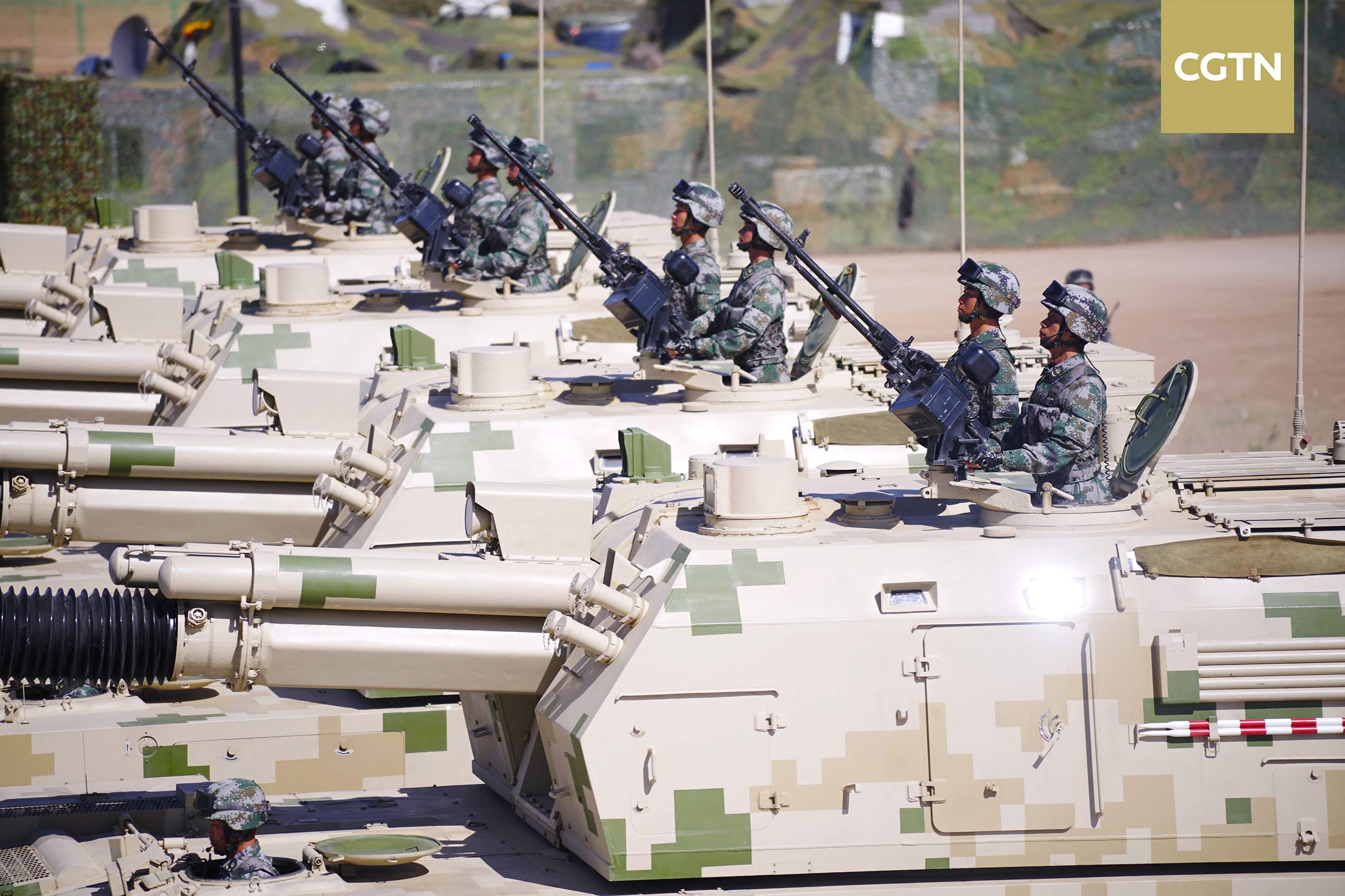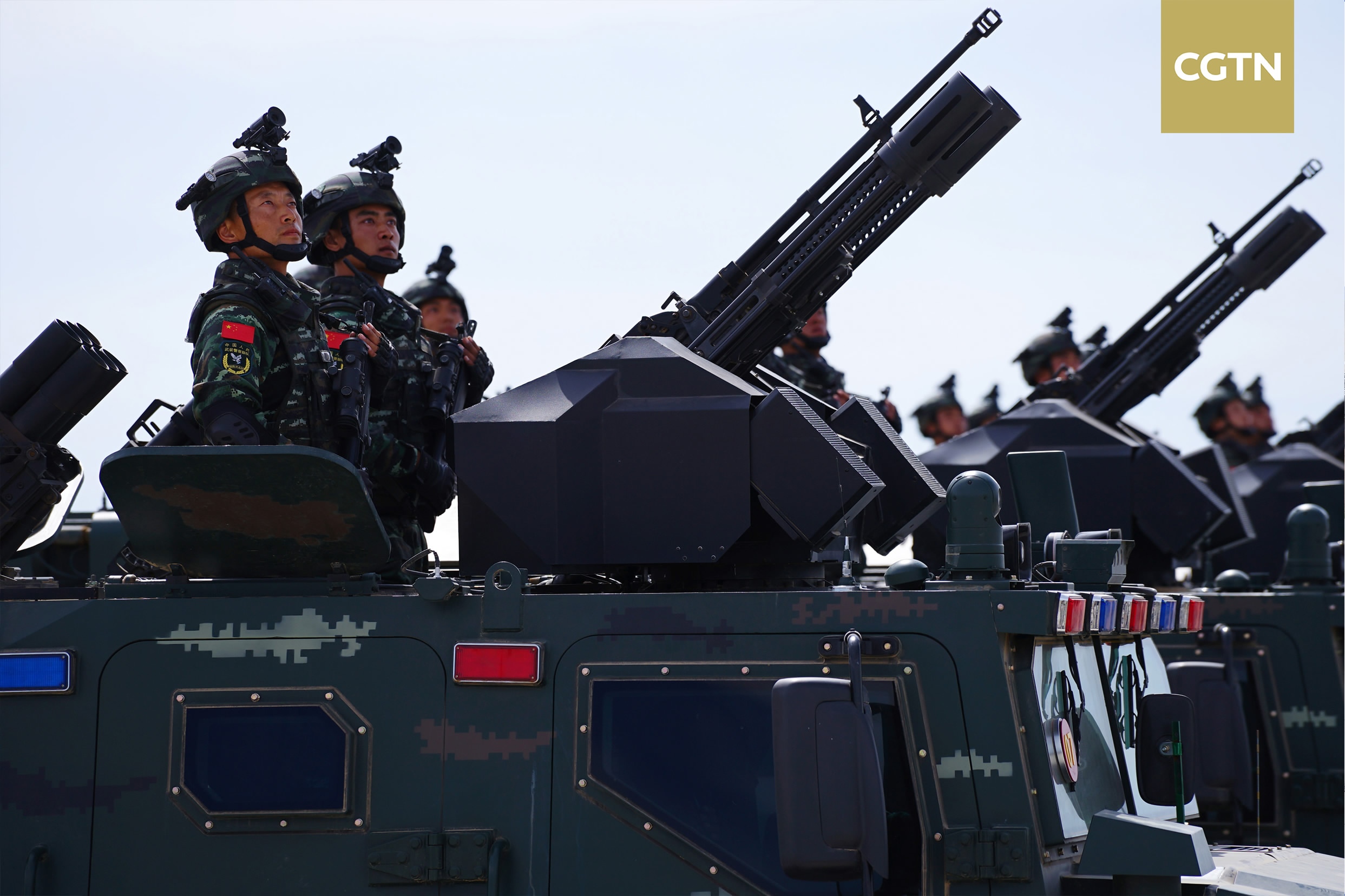By CGTN's Bi Jianlu
Chinese President Xi Jinping on Sunday oversaw a grand military parade at the Zhurihe training base in northern China's Inner Mongolia Autonomous Region. President Xi ordered the country's military to further improve its combativeness, noting that the PLA must focus on war preparedness and forge an elite and powerful force that is always "ready to fight, capable of combat, and sure to win."
The parade was held to commemorate the PLA's 90th founding anniversary, which falls on August 1.
So, what distinguishes this spectacle from other military events?

Chinese President Xi Jinping oversaw a grand military parade at the Zhurihe training base in northern China's Inner Mongolia Autonomous Region on July 30, 2017. /CCTV Photo
First-ever Army Day military parade in the field
Today’s parade was the first time that China has held a large military parade in the field.
The military show was a breakaway from the formalities of ceremonial parades – no military bands, no public attendance, no grooming and even no goose-stepping march.
Parade elements irrelevant to real battles have been reduced to a minimum. Dressed in camouflage fatigues, President Xi himself inspected the troops from an open-top military jeep.

CGTN Photo
More than 12,000 service personnel from the air force, army and navy, as well as the newly-formed rocket force and strategic support troops, took part in the parade.
The armaments and aircraft were arranged in nine combat groups. Previous National Day parades only distinguished the participating troop formations as ground armament formations and air echelons.
It was also the first time that China has commemorated Army Day with a military parade since the founding of the People’s Republic of China in 1949.

CGTN Photo
Half of displayed armaments make grand debut
Over 600 pieces of armament and 100 aircraft were displayed with nearly half of the weapons either new or modified versions that had hardly been shown in public before.

CGTN Photo
Among the new weaponry were the HQ-9B surface-to-air missiles capable of intercepting enemy tactic ballistic missiles, and the HQ-22 SAM missiles designed to intercept fixed-wing aircraft and cruise missiles.

CGTN Photo
Also on display were the YJ-83K air-to-ship missiles, which can operate in all weather conditions and at all altitudes, and deliver precision strikes on multiple, beyond-visual-range targets. The YJ-83K missiles are designed to mainly strike medium- to large-size surface vessels and flotillas.

CGTN Photo
But the highlight of the parade was the host of conventional and nuclear missiles from the PLA's newly established Rocket Force.

CGTN Photo
They include the Dongfeng-26 ballistic missile, which can be fired at short notice and fitted with a nuclear warhead, the Dongfeng-21D land-based anti-ship ballistic missile described by some as the "carrier killer", and the Dongfeng-16G conventional missile designed for precision strikes against key enemy targets.

CGTN Photo
Parade comes at critical moment in PLA reform
The PLA is in the midst of an unprecedented reform led by President Xi to improve its combat capabilities. The PLA has come a long way since its birth during the Nanchang Uprising on August 1, 1927. Today, the PLA commands about two million service personnel, one of the world's largest military forces.
Just several days ago, President Xi said at a workshop of provincial and ministerial officials that military reform is historic and lauded breakthroughs and achievements in major fields.

Infographic of Chinese Military Reform /Merics Photo
The president put forward the dream of building a strong army during an inspection of the armed forces in southern China in December 2012, less than a month after he assumed office as general secretary of the CPC Central Committee and chairman of the CPC Central Military Commission (CMC).
A series of major structural reforms have been made public since December 31, 2015, following the establishment of the PLA Army General Command, the PLA Rocket Force and the PLA Strategic Support Force.

Chinese President Xi Jinping (L, front), also general secretary of the Communist Party of China (CPC) Central Committee and chairman of the Central Military Commission, confers a military flag to Commander Liu Yuejun and Political Commissar Zheng Weiping of the Eastern Theater Command in Beijing, China, Feb. 1, 2016. /CGTN Photo
The following month, the four general departments – staff, politics, logistics, and armaments – were reorganized into 15 agencies of the CMC, and five theater commands were initiated on February 1, replacing the seven military area commands.
The reforms also stress the importance of regulating power within the military, demanding a strict system to supervise the use of power. A new discipline inspection commission has been established within the CMC, and disciplinary inspectors have been sent to CMC departments and theater commands.
Related stories:
Xi: Chinese military forces committed to safeguarding peace
PLA's 90th founding anniversary: Highlights of the grand military parade









